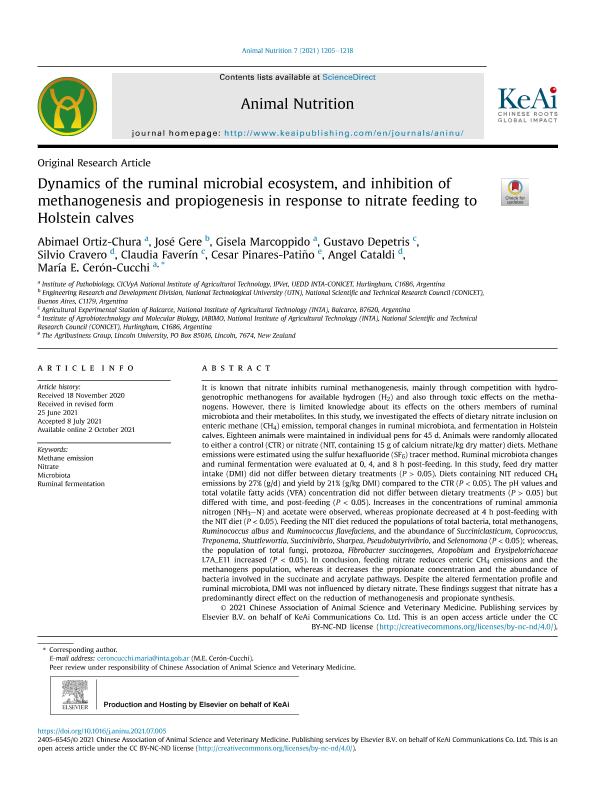Mostrar el registro sencillo del ítem
dc.contributor.author
Ortiz Chura, Abimael

dc.contributor.author
Gere, José Ignacio

dc.contributor.author
Marcoppido, Gisela Ariana

dc.contributor.author
Depetris, Gustavo Jesus

dc.contributor.author
Cravero, Silvio Lorenzo Pedro

dc.contributor.author
Faverín, Claudia
dc.contributor.author
Pinares Patiño, Cesar
dc.contributor.author
Cataldi, Angel Adrian

dc.contributor.author
Cerón Cucchi, María Esperanza

dc.date.available
2022-08-22T15:09:44Z
dc.date.issued
2021-12
dc.identifier.citation
Ortiz Chura, Abimael; Gere, José Ignacio; Marcoppido, Gisela Ariana; Depetris, Gustavo Jesus; Cravero, Silvio Lorenzo Pedro; et al.; Dynamics of the ruminal microbial ecosystem, and inhibition of methanogenesis and propiogenesis in response to nitrate feeding to Holstein calves; Elsevier; Animal Nutrition; 7; 4; 12-2021; 1205-1218
dc.identifier.issn
2405-6383
dc.identifier.uri
http://hdl.handle.net/11336/166224
dc.description.abstract
It is known that nitrate inhibits ruminal methanogenesis, mainly through competition with hydrogenotrophic methanogens for available hydrogen (H2) and also through toxic effects on the methanogens. However, there is limited knowledge about its effects on the others members of ruminal microbiota and their metabolites. In this study, we investigated the effects of dietary nitrate inclusion on enteric methane (CH4) emission, temporal changes in ruminal microbiota, and fermentation in Holstein calves. Eighteen animals were maintained in individual pens for 45 d. Animals were randomly allocated to either a control (CTR) or nitrate (NIT, containing 15 g of calcium nitrate/kg dry matter) diets. Methane emissions were estimated using the sulfur hexafluoride (SF6) tracer method. Ruminal microbiota changes and ruminal fermentation were evaluated at 0, 4, and 8 h post-feeding. In this study, feed dry matter intake (DMI) did not differ between dietary treatments (P > 0.05). Diets containing NIT reduced CH4 emissions by 27% (g/d) and yield by 21% (g/kg DMI) compared to the CTR (P < 0.05). The pH values and total volatile fatty acids (VFA) concentration did not differ between dietary treatments (P > 0.05) but differed with time, and post-feeding (P < 0.05). Increases in the concentrations of ruminal ammonia nitrogen (NH3–N) and acetate were observed, whereas propionate decreased at 4 h post-feeding with the NIT diet (P < 0.05). Feeding the NIT diet reduced the populations of total bacteria, total methanogens, Ruminococcus albus and Ruminococcus flavefaciens, and the abundance of Succiniclasticum, Coprococcus, Treponema, Shuttlewortia, Succinivibrio, Sharpea, Pseudobutyrivibrio, and Selenomona (P < 0.05); whereas, the population of total fungi, protozoa, Fibrobacter succinogenes, Atopobium and Erysipelotrichaceae L7A_E11 increased (P < 0.05). In conclusion, feeding nitrate reduces enteric CH4 emissions and the methanogens population, whereas it decreases the propionate concentration and the abundance of bacteria involved in the succinate and acrylate pathways. Despite the altered fermentation profile and ruminal microbiota, DMI was not influenced by dietary nitrate. These findings suggest that nitrate has a predominantly direct effect on the reduction of methanogenesis and propionate synthesis.
dc.format
application/pdf
dc.language.iso
eng
dc.publisher
Elsevier

dc.rights
info:eu-repo/semantics/openAccess
dc.rights.uri
https://creativecommons.org/licenses/by-nc-nd/2.5/ar/
dc.subject
METHANE EMISSION
dc.subject
MICROBIOTA
dc.subject
NITRATE
dc.subject
RUMINAL FERMENTATION
dc.subject.classification
Ganadería

dc.subject.classification
Producción Animal y Lechería

dc.subject.classification
CIENCIAS AGRÍCOLAS

dc.title
Dynamics of the ruminal microbial ecosystem, and inhibition of methanogenesis and propiogenesis in response to nitrate feeding to Holstein calves
dc.type
info:eu-repo/semantics/article
dc.type
info:ar-repo/semantics/artículo
dc.type
info:eu-repo/semantics/publishedVersion
dc.date.updated
2022-08-19T15:14:51Z
dc.journal.volume
7
dc.journal.number
4
dc.journal.pagination
1205-1218
dc.journal.pais
Países Bajos

dc.journal.ciudad
Amsterdam
dc.description.fil
Fil: Ortiz Chura, Abimael. Instituto Nacional de Tecnología Agropecuaria. Centro de Investigación En Ciencias Veterinarias y Agronómicas. Instituto de Patobiología Veterinaria.
Consejo Nacional de Investigaciones Científicas y Técnicas. Oficina de Coordinación Administrativa Parque Centenario. Instituto de Patobiología Veterinaria; Argentina
dc.description.fil
Fil: Gere, José Ignacio. Consejo Nacional de Investigaciones Científicas y Técnicas; Argentina. Universidad Tecnológica Nacional. Facultad Regional Buenos Aires. Unidad de Investigación y Desarrollo de las Ingenierías; Argentina
dc.description.fil
Fil: Marcoppido, Gisela Ariana. Instituto Nacional de Tecnología Agropecuaria. Centro de Investigación En Ciencias Veterinarias y Agronómicas. Instituto de Patobiología Veterinaria.
Consejo Nacional de Investigaciones Científicas y Técnicas. Oficina de Coordinación Administrativa Parque Centenario. Instituto de Patobiología Veterinaria; Argentina
dc.description.fil
Fil: Depetris, Gustavo Jesus. Instituto Nacional de Tecnología Agropecuaria. Centro Regional Buenos Aires Sur. Estación Experimental Agropecuaria Balcarce. Agencia de Extensión Rural Balcarce; Argentina
dc.description.fil
Fil: Cravero, Silvio Lorenzo Pedro. Instituto Nacional de Tecnología Agropecuaria. Centro de Investigación en Ciencias Veterinarias y Agronómicas. Instituto de Agrobiotecnología y Biología Molecular. Consejo Nacional de Investigaciones Científicas y Técnicas. Oficina de Coordinación Administrativa Parque Centenario. Instituto de Agrobiotecnología y Biología Molecular; Argentina
dc.description.fil
Fil: Faverín, Claudia. Instituto Nacional de Tecnología Agropecuaria. Centro Regional Buenos Aires Sur. Estación Experimental Agropecuaria Balcarce. Agencia de Extensión Rural Balcarce; Argentina
dc.description.fil
Fil: Pinares Patiño, Cesar. Lincoln University.; Nueva Zelanda
dc.description.fil
Fil: Cataldi, Angel Adrian. Instituto Nacional de Tecnología Agropecuaria. Centro de Investigación en Ciencias Veterinarias y Agronómicas. Instituto de Agrobiotecnología y Biología Molecular. Consejo Nacional de Investigaciones Científicas y Técnicas. Oficina de Coordinación Administrativa Parque Centenario. Instituto de Agrobiotecnología y Biología Molecular; Argentina
dc.description.fil
Fil: Cerón Cucchi, María Esperanza. Instituto Nacional de Tecnología Agropecuaria. Centro de Investigación En Ciencias Veterinarias y Agronómicas. Instituto de Patobiología Veterinaria.
Consejo Nacional de Investigaciones Científicas y Técnicas. Oficina de Coordinación Administrativa Parque Centenario. Instituto de Patobiología Veterinaria; Argentina
dc.journal.title
Animal Nutrition
dc.relation.alternativeid
info:eu-repo/semantics/altIdentifier/url/https://linkinghub.elsevier.com/retrieve/pii/S2405654521001657
dc.relation.alternativeid
info:eu-repo/semantics/altIdentifier/doi/http://dx.doi.org/10.1016/j.aninu.2021.07.005
Archivos asociados
